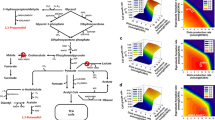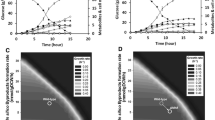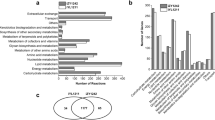Abstract
Klebsiella oxytoca naturally produces a large amount of 2,3-butanediol (2,3-BD), a promising bulk chemical with wide industrial applications, along with various byproducts. In this study, the in silico gene knockout simulation of K. oxytoca was carried out for 2,3-BD overproduction by inhibiting the formation of byproducts. The knockouts of ldhA and pflB genes were targeted with the criteria of maximization of 2,3-BD production and minimization of byproducts formation. The constructed K. oxytoca ΔldhA ΔpflB strain showed higher 2,3-BD yields and higher final concentrations than those obtained from the wild-type and ΔldhA strains. However, the simultaneous deletion of both genes caused about a 50 % reduction in 2,3-BD productivity compared with K. oxytoca ΔldhA strain. Based on previous studies and in silico investigation that the agitation speed during 2,3-BD fermentation strongly affected cell growth and 2,3-BD synthesis, the effect of agitation speed on 2,3-BD production was investigated from 150 to 450 rpm in 5-L bioreactors containing 3-L culture media. The highest 2,3-BD productivity (2.7 g/L/h) was obtained at 450 rpm in batch fermentation. Considering the inhibition of acetoin for 2,3-BD production, fed-batch fermentations were performed using K. oxytoca ΔldhA ΔpflB strain to enhance 2,3-BD production. Altering the agitation speed from 450 to 350 rpm at nearly 10 g/L of acetoin during the fed-batch fermentation allowed for the production of 113 g/L 2,3-BD, with a yield of 0.45 g/g, and for the production of 2.1 g/L/h of 2,3-BD.






Similar content being viewed by others
References
Asadollahi MA, Maury J, Patil KR, Schalk M, Clark A, Nielsen J (2009) Enhancing sesquiterpene production in Saccharomyces cerevisiae through in silico driven metabolic engineering. Metab Eng 11:328–334
Becker J, Wittmann C (2012) Systems and synthetic metabolic engineering for amino acid production—the heartbeat of industrial strain development. Curr Opin Biotechnol 23:718–726
Becker J, Zelder O, Hafner S, Schroder H, Wittmann C (2011) From zero to hero–design-based systems metabolic engineering of Corynebacterium glutamicum for l-lysine production. Metab Eng 13:159–168
Cao N, Xia Y, Gong CS, Tsao GT (1997) Production of 2,3-butanediol from pretreated corn cob by Klebsiella oxytoca in the presence of fungal cellulase. Appl Biochem Biotechnol 63–65:129–139
Cassey B, Guest JR, Attwood MM (1998) Environmental control of pyruvate dehydrogenase complex expression in Escherichia coli. FEMS Microbiol Lett 159:325–329
Celinska E, Grajek W (2009) Biotechnological production of 2,3-butanediol—current state and prospects. Biotechnol Adv 27:715–725
Champluvier B, Decallonne J, Rouxhet PG (1989) Influence of sugar source (lactose, glucose, galactose) on 2,3-butanediol production by Klebsiella oxytoca NRRL-B199. Arch Microbiol 152:411–414
Chen Z, Liu HJ, Zhang J-A, Liu DH (2009) Cell physiology and metabolic flux response of Klebsiella pneumoniae to aerobic conditions. Process Biochem 44:862–868
Cho JH, Rathnasingh C, Song H, Chung BW, Lee HJ, Seung D (2012) Fermentation and evaluation of Klebsiella pneumoniae and K. oxytoca on the production of 2,3-butanediol. Bioprocess Biosyst Eng 35:1081–1088
Choi HS, Lee SY, Kim TY, Woo HM (2010) In silico identification of gene amplification targets for improvement of lycopene production. Appl Environ Microbiol 76:3097–3105
Edwards JS, Ramakrishna R, Schilling CH, Palsson BO (1999) Metabolic flux balance analysis. In: Lee SY, Papoutsakis ET (eds) Metabolic engineering. Marcel Dekker Inc., New York, pp 13–57
Furusawa C, Horinouchi T, Hirasawa T, Shimizu H (2013) Systems metabolic engineering: the creation of microbial cell factories by rational metabolic design and evolution. Adv Biochem Eng Biotechnol 131:1–23
Garg SK, Jain A (1995) Fermentative production of 2,3-butanediol: a review. Bioresour Technol 51:103–109
Gombert AK, Nielsen J (2000) Mathematical modelling of metabolism. Curr Opin Biotechnol 11:180–186
Hatti-Kaul R, Tornvall U, Gustafsson L, Borjesson P (2007) Industrial biotechnology for the production of bio-based chemicals—a cradle-to-grave perspective. Trends Biotechnol 25:119–124
Jansen NB, Flickinger MC, Tsao GT (1984) Production of 2,3-butanediol from d-xylose by Klebsiella oxytoca ATCC 8724. Biotechnol Bioeng 26:362–369
Ji XJ, Huang H, Du J, Zhu JG, Ren LJ, Hu N, Li S (2009) Enhanced 2,3-butanediol production by Klebsiella oxytoca using a two-stage agitation speed control strategy. Bioresour Technol 100:3410–3414
Ji XJ, Huang H, Du J, Zhu JG, Ren LJ, Li S, Nie ZK (2009) Development of an industrial medium for economical 2,3-butanediol production through co-fermentation of glucose and xylose by Klebsiella oxytoca. Bioresour Technol 100:5214–5218
Ji XJ, Huang H, Li S, Du J, Lian M (2008) Enhanced 2,3-butanediol production by altering the mixed acid fermentation pathway in Klebsiella oxytoca. Biotechnol Lett 30:731–734
Ji XJ, Huang H, Ouyang PK (2011) Microbial 2,3-butanediol production: a state-of-the-art review. Biotechnol Adv 29:351–364
Ji XJ, Huang H, Zhu JG, Ren LJ, Nie ZK, Du J, Li S (2010) Engineering Klebsiella oxytoca for efficient 2,3-butanediol production through insertional inactivation of acetaldehyde dehydrogenase gene. Appl Microbiol Biotechnol 85:1751–1758
Ji XJ, Nie ZK, Huang H, Ren LJ, Peng C, Ouyang PK (2011) Elimination of carbon catabolite repression in Klebsiella oxytoca for efficient 2,3-butanediol production from glucose-xylose mixtures. Appl Microbiol Biotechnol 89:1119–1125
Jung YK, Kim TY, Park SJ, Lee SY (2010) Metabolic engineering of Escherichia coli for the production of polylactic acid and its copolymers. Biotechnol Bioeng 105:161–171
Kim D-K, Rathnasingh C, Song H, Lee HJ, Seung D, Chang YK (2013) Metabolic engineering of a novel Klebsiella oxytoca strain for enhanced 2,3-butanediol production. J Biosci Bioeng 116:186–192
Lee JW, Kim TY, Jang YS, Choi S, Lee SY (2011) Systems metabolic engineering for chemicals and materials. Trends Biotechnol 29:370–378
Lee JW, Na D, Park JM, Lee J, Choi S, Lee SY (2012) Systems metabolic engineering of microorganisms for natural and non-natural chemicals. Nat Chem Biol 8:536–546
Lee KH, Park JH, Kim TY, Kim HU, Lee SY (2007) Systems metabolic engineering of Escherichia coli for l-threonine production. Mol Syst Biol 3:149
Mahadevan R, Schilling CH (2003) The effects of alternate optimal solutions in constraint-based genome-scale metabolic models. Metab Eng 5:264–276
Ng CY, Jung MY, Lee J, Oh MK (2012) Production of 2,3-butanediol in Saccharomyces cerevisiae by in silico aided metabolic engineering. Microb Cell Fact 11:68
Nie ZK, Ji XJ, Huang H, Du J, Li ZY, Qu L, Zhang Q, Ouyang PK (2011) An effective and simplified fed-batch strategy for improved 2,3-butanediol production by Klebsiella oxytoca. Appl Biochem Biotechnol 163:946–953
Oliver JW, Machado IM, Yoneda H, Atsumi S (2013) Cyanobacterial conversion of carbon dioxide to 2,3-butanediol. Proc Natl Acad Sci USA 110:1249–1254
Orth JD, Conrad TM, Na J, Lerman JA, Nam H, Feist AM, Palsson BO (2011) A comprehensive genome-scale reconstruction of Escherichia coli metabolism—2011. Mol Syst Biol 7:535
Park JH, Lee KH, Kim TY, Lee SY (2007) Metabolic engineering of Escherichia coli for the production of l-valine based on transcriptome analysis and in silico gene knockout simulation. Proc Natl Acad Sci USA 104:7797–7802
Park JH, Lee SY (2008) Towards systems metabolic engineering of microorganisms for amino acid production. Curr Opin Biotechnol 19:454–460
Park JM, Kim TY, Lee SY (2009) Constraints-based genome-scale metabolic simulation for systems metabolic engineering. Biotechnol Adv 27:979–988
Park JM, Kim TY, Lee SY (2010) Prediction of metabolic fluxes by incorporating genomic context and flux-converging pattern analyses. Proc Natl Acad Sci USA 107:14931–14936
Park JM, Park HM, Kim WJ, Kim HU, Kim TY, Lee SY (2012) Flux variability scanning based on enforced objective flux for identifying gene amplification targets. BMC Syst Biol 6:106
Park JM, Song H, Lee HJ, Seung D (2013) Genome-scale reconstruction and in silico analysis of Klebsiella oxytoca for 2,3-butanediol production. Microb Cell Fact 12:20
Qureshi N, Cheryan M (1989) Production of 2,3-butanediol by Klebsiella oxytoca. Appl Microbiol Biotechnol 30:440–443
Reed JL, Palsson BO (2004) Genome-scale in silico models of E. coli have multiple equivalent phenotypic states: assessment of correlated reaction subsets that comprise network states. Genome Res 14:1797–1805
Schuetz R, Kuepfer L, Sauer U (2007) Systematic evaluation of objective functions for predicting intracellular fluxes in Escherichia coli. Mol Syst Biol 3:119
Shin JH, Kim HU, Kim DI, Lee SY (2012) Production of bulk chemicals via novel metabolic pathways in microorganisms. Biotechnol Adv. doi:10.1016/j.biotechadv.2012.12.008
Stephanopoulos G, Aristidou AA, Nielsen JH (1998) Metabolic engineering: principles and methodologies. Academic Press, San Diego
Varma A, Palsson BO (1994) Metabolic flux balancing: basic concepts, scientific and practical use. Biotechnology 12:994–998
Volch M, Jansen NB, Ladisch MR, Tsao GT, Narayan R, Rodwell VW (1985) 2,3-butanediol. In: Murray M-Y (ed) Comprehensive Biotechnology, vol 3, 1st edn. Pergamon Press, New York, pp 932–947
Weusthuis RA, Lamot I, van der Oost J, Sanders JP (2011) Microbial production of bulk chemicals: development of anaerobic processes. Trends Biotechnol 29:153–158
Yang G, Tian J, Li J (2007) Fermentation of 1,3-propanediol by a lactate deficient mutant of Klebsiella oxytoca under microaerobic conditions. Appl Microbiol Biotechnol 73:1017–1024
Zeng AP, Sabra W (2011) Microbial production of diols as platform chemicals: recent progresses. Curr Opin Biotechnol 22:749–757
Acknowledgments
This work was supported by the Industrial Strategic Technology Development Program (No. 10035241) funded by the Ministry of Trade, Industry & Energy (MOTIE, Korea).
Author information
Authors and Affiliations
Corresponding author
Rights and permissions
About this article
Cite this article
Park, J.M., Song, H., Lee, H.J. et al. In silico aided metabolic engineering of Klebsiella oxytoca and fermentation optimization for enhanced 2,3-butanediol production. J Ind Microbiol Biotechnol 40, 1057–1066 (2013). https://doi.org/10.1007/s10295-013-1298-y
Received:
Accepted:
Published:
Issue Date:
DOI: https://doi.org/10.1007/s10295-013-1298-y




